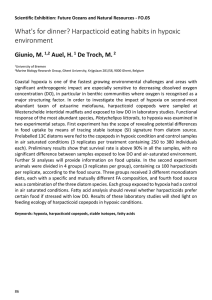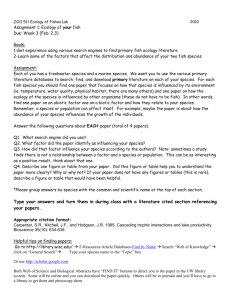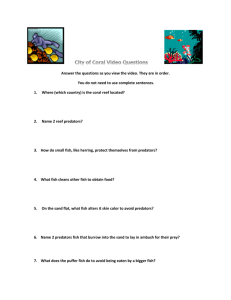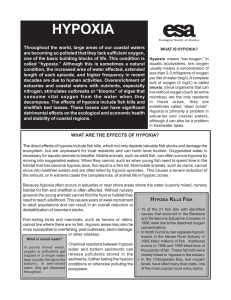Biological response
advertisement
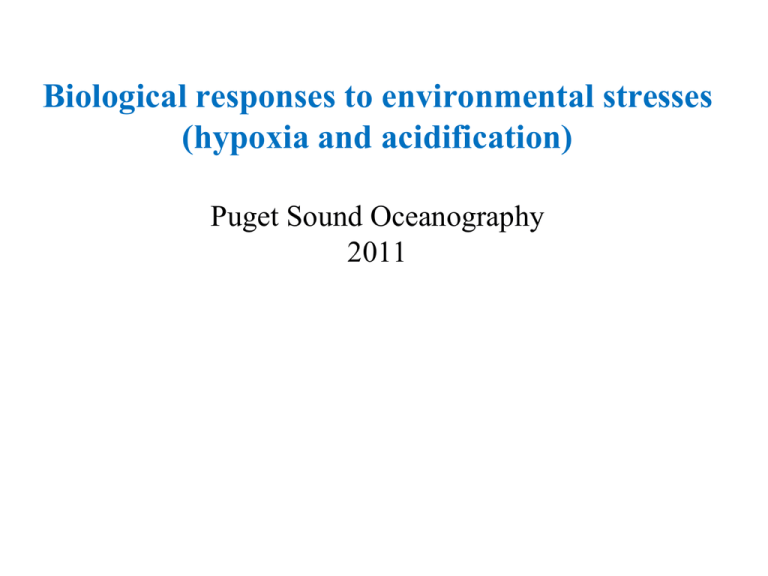
Biological responses to environmental stresses (hypoxia and acidification) Puget Sound Oceanography 2011 Climate projections Ocean Atmospheric ‘Business as usual’ With emissions mitigation pH along St. George California transect Feely et al., 2002 Calcium carbonate (as aragonite) saturation depths: from 1991-1996 cruises. Feely et al., 2002 February 2008 August 2008 Brittlestar adults increase calcification Oysters – decreased growth and calcification Wood et al, 2008 3500ppm Net calcification 380ppm Calcium content (g) Beniash et al, 2010 Pteropod – shell dissolution Control Deformed Limacina 7.4 Normal CaCO3 precipitated Krill – deformed eggs, reduced hatching pH 7.7 Control low pH Sea urchins – deformed larvae pH 8.1 pH 7.8 Kawaguchi et al, 2010 incubation time Fabry et al, 2008 Comeau et al. 2009 Kurihara et al, 2008 Biological effects on invertebrates: Compensation (when present) shown to usually come at energetic expense. Mean effect size Highly variable, mostly (but not all) negative effects. Doney et al, 2009 Impacts on fish? Salmon, herring, and mackerel prey: Changes in prey: Lab experiments: low pH affects sensory systems; changes behavior: Leads to mortality in the field : Hypoxia Primary effects: • mortality • physiological stress / impaired abilities • increased/decreased metabolic functions Secondary effects: • habitat loss • decreased prey abundance • changes in predation / predation risk Field observations of fish distributions – low abundances in hypoxic water Vertical distributions of fish and some zooplankton change in response to hypoxia: May (oxic bottom water) Fish abundance Depth Fish abundance (Copepods) Fish abundance August (hypoxic bottom water) Depth Fish abundance (Copepods) (Copepods) Stanley and Wilson, 2004 (Copepods) Roman, 1993 Benthos Hypoxic ------------------------------------------------------------------------Oxic water column Diaz and Rosenberg (1995) What drives changes in distributions? • • • • Avoidance? Direct mortality? Indirect mortality (e.g., predation)? Population-level changes (growth, reproduction)? High mortality in hypoxic water. Species-specific thresholds copepods Roman (1993) episodic vs. chronic Avoidance: Behavioral trade-offs: Habitat preference vs. predation risk Fish larvae avoid hypoxia, increasing overlap with predators Treatment: Without Striped Bass Oxygen (mg/l) 2 4 6 predators predators Pycnocline Predator avoidance Without Striped Bass Oxygen (mg/l) predators predators 2 4 6 Pycnocline Effects of hypoxia depend on species: Physiology: Dissolved oxygen (mg/l) Predation rates: # of prey eaten Dissolved oxygen (mg/l) Breitburg 1994 Vertical movement of Aurelia under five oxygen conditions “Normal” Lots of vertical movement Each coloured line is the track of an individual specimen over a 1 h period. Thuesen et al. J Exp Biol 2005 Multiple stressors: Habitat squeeze: high temperatures and low dissolved oxygen Dissolved Oxygen <5mg/l=stress <3mg/l=mortality Water temperature >25C = stress and mortality August 18-20, 2003 Courtesy E. North, UMD, HPL Main Stem Hood Canal oxygen patterns: Ocean end Hoodsport Hood Canal oxygen and density profiles: Bioacoustic surveys Hoodsport, September 2006 Night Day 0 0 5 10 15 0 0 20 20 40 40 60 60 80 80 100 100 120 120 140 140 20 5 10 15 20 Surface zooplankton layer Fish separated from their prey

